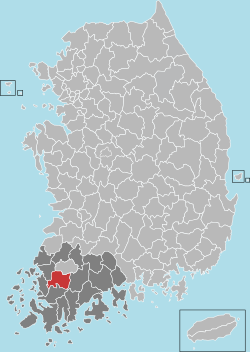Naju
Naju
나주 | |
|---|---|
Municipal city | |
| Korean transcription(s) | |
| • Hangul | 나주시 |
| • Hanja | 羅州市 |
| • Revised Romanization | Naju-si |
| • McCune–Reischauer | Raju-si |
 Flag  Emblem of Naju | |
 Location in South Korea | |
| Coordinates: 35°02′N 126°43′E / 35.033°N 126.717°ECoordinates: 35°02′N 126°43′E / 35.033°N 126.717°E | |
| Country | |
| Region | Honam |
| Administrative divisions | 1 eup, 12 myeon, 6 dong |
| Area | |
| • Total | 603.88 km2 (233.16 sq mi) |
| Population (2014) | |
| • Total | 88,739 |
| • Density | 146.9/km2 (380/sq mi) |
| • Dialect | Jeolla |
Naju (Korean pronunciation: [na̞.dzu]) is a city in South Jeolla Province, South Korea.
The capital of South Jeolla was located at Naju until it was moved to Gwangju in 1895. The name Jeolla actually originates from the first character of Jeonju (전; 全) and the first character of Naju (라; 羅; nowadays spelled and pronounced 나/na according to the South Korean standard). Dongshin University is situated in Naju. Naju is famous for the Naju Pear which is a large round pear that forms its district logo.
History[]
- In the Later Three Kingdoms period of Korean history, Wang Geon (later Taejo of Goryeo Dynasty) occupied the Naju area, which was then part of Later Baekje Kingdom and came to become large base of his political support. He also married the daughter of the Magistrate of Naju, Lady Janghwa, who became the mother of Goryeo's second King Hyejong of Goryeo.[1]
- In 1986, the governmental name was changed from Geumseong to Naju.[2]
- In 1995, Naju city was expanded to include Naju county.[3]
Products[]
A well-known local product is the Naju pear, which has long been cultivated along the Yeongsan River.[4]
Naju pears and muskmelons are popular as gifts for Lunar New Year and other holidays.
Innovation city[]
Naju was designated an Innovation City and the opening ceremony for city construction was held on November 8, 2007. President Roh participated in the opening events.
As the city won the title of "Innovation City", several public organizations have relocated to here from Seoul. Start of the construction was 4th in line after Jeju, Gimcheon and Jinju. The organizations that were the targeted for moving are:[5]
Energy[]
- Korea Electric Power Corporation (KEPCO)
- KEPCO Plant Service & Engineering Co., Ltd. (KEPCO KPS)
- Korea Electric Power Data Network Co. Ltd. (KEPCO KDN)
- Korea Power Exchange (KPX)
IT & Communications[]
- Korea Post Information Center (KPIC)
- Korea Internet & Security Agency (KISA)
- National Radio Research Agency (RRA)
- Korea Communications Agency (KCA)
Agriculture[]
- Korea Rural Community Corporation (KRC)
- Korea Agro-Fisheries & Food Trade Corporation (aT)
- Korea Rural Economic Institute (KREI)
- Food and Agriculture Officials Training Institute (ATI)
- Korea Institute of Planning and Evaluation for Technology in Food, Agriculture and Forestry (IPET)
Culture & Others[]
- Arts Council Korea (ARKO)
- Korea Creative Content Agency (KOCCA)
- Teachers' Pension (TP)
The new city is set to be 7.327 square kilometres (2.83 sq mi) in area with the grand plan of developing it into a cultural center in the southwestern economy.[6]
Near the Innovation City is the Naju Pear Museum and Pear Orchard for Tourists (나주배박물관 및 배밭 관광체험), which is dedicated to the Asian pear; all of its displays are in Korean.
Symbols[]
- Flower: Pear blossoms
- Bird: Dove
- Tree: Ginkgo Tree
Festivals[]
- Naju Pear Blossom Festival in April
- Naju Rapeseed Festival in May
- Naju Yeongsanpo Skate Festival in May
International relations[]
Twin towns and sister cities[]
Naju is twinned with:
 Kurayoshi, Tottori, Japan
Kurayoshi, Tottori, Japan Wenatchee, Washington, United States
Wenatchee, Washington, United States Isaac, Queensland, Australia
Isaac, Queensland, Australia Nanchang, Jiangxi, China (since 2007)[7]
Nanchang, Jiangxi, China (since 2007)[7]
Culture[]
The drama Jumong was filmed in Naju. An amusement park called 'Samhanji Theme Park' was used for the film set because of its traditional sceneries.
It hosts events such as hands-on experience on natural dyeing process for children. Many elementary schools are registering for this program.[8]
See also[]
References[]
- ^ Establishment of city and county according to Constitution of the Republic of Korea(1981.4.13)
- ^ Provisional changes including Guri city and 11 cities and counties and permission of modification naming Naju.(1985.12.28.) from Constitution of the Republic of Korea
- ^ Institution dealing with complex of city-county.(1994.8.3.)
- ^ "Local Specialties - Shopping - Tourism/Shopping - NAJUSI".
- ^ 혁신도시 (in Korean). Retrieved 2021-04-28.
- ^ "혁신도시" (in Korean). Ministry of Land, Infrastructure and Transport.
- ^ "Nanchang City and Sister Cities Intercommunion". Nanchang Municipal Party Committee of the CPC and Nanchang Municipal Government. Nanchang Economic Information Center. Archived from the original on 2013-05-22. Retrieved 2013-11-05.
- ^ 나주 천연염색문화관 체험현장 ‘각광’ [Experiencing the Naju Natural Dyeing Culture Center is Becoming Popular]. dailian.co.kr.
External links[]
- Naju
- Cities in South Jeolla Province

